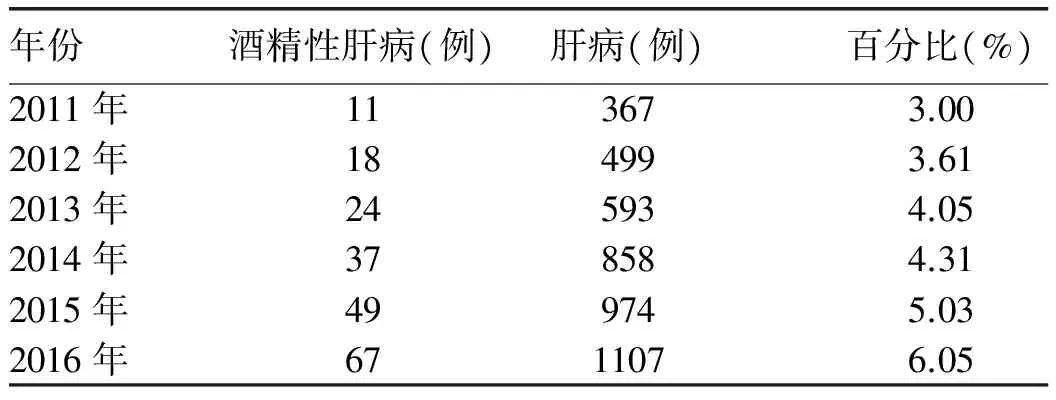206例酒精性肝病患者的临床特点
2017-09-18高广甫张淑凤王长武高红伟
高广甫, 张淑凤, 王长武, 高红伟
(郑州大学第五附属医院 消化内科, 郑州 450005)
论著/其他
206例酒精性肝病患者的临床特点
高广甫, 张淑凤, 王长武, 高红伟
(郑州大学第五附属医院 消化内科, 郑州 450005)
目的探讨酒精性肝病的临床特征,为其防治策略的制订提供理论依据。方法收集2011年1月-2016年12月郑州大学第五附属医院收治的206例酒精性肝病患者的临床资料。分析不同酒精性肝病的构成情况以及2011-2016年酒精性肝病占所有肝病患者的比例及其变化趋势;分析各种酒精性肝病患者的年龄分布特点;对比2011-2013年和2014-2016年前后3年各种酒精性肝病的构成情况。计数资料组间比较采用χ2检验。结果酒精性肝硬化占比69.90%(144/206),其次为酒精性肝炎,占19.42%。2011-2016年酒精性肝病占同期住院肝病患者的比例呈现逐年上升的趋势。40~60岁年龄段酒精性肝病的发病率最高,为66.99%(138/206);酒精性脂肪肝以40~60岁年龄段的发病率最高,>60岁年龄段的发病率显著低于其他年龄段(χ2=8.16,P=0.01);40~60岁年龄段酒精性肝炎占比18.84%(26/138),酒精性肝硬化占比68.84%(95/138),酒精性慢加急性肝衰竭占比5.07%(7/138)。2014-2016年收治的酒精性肝病患者中,酒精性肝硬化占比显著高于2011-2013年酒精性肝硬化患者所占比例(73.20% vs 60.38%,χ2=9.24,P<0.05)。结论酒精性肝病好发于40~60岁人群,临床应当加强酒精性肝病的早期诊治,延缓或逆转肝纤维化及肝硬化发生。
肝疾病, 酒精性; 疾病特征
近年来,随着人们饮食结构的改变,酗酒人群的数量不断增加,酒精性肝病的发病率也呈上升趋势,成为导致肝损伤的重要病因[1-3]。长期酗酒是酒精性肝病的直接致病原因,早期酒精性肝病主要表现为脂肪肝、酒精性肝炎,如果通过严格戒酒、保护肝功能等治疗,肝脏的病变可以逆转。但是,一旦出现肝纤维化、肝硬化,则病情难以逆转[4-5],因此,早期针对性的干预对酒精性肝硬化的预防和治疗有重要意义。本研究对酒精性肝病患者的临床资料进行回顾性分析,探讨酒精性肝病的疾病特点,为本病防治策略的制订提供理论依据。
1 资料与方法
1.1 研究对象 回顾性分析2011年1月-2016年12月本院收治的酒精性肝病患者的临床资料。根据换算公式:乙醇(g)=含乙醇饮料(ml)×乙醇浓度(%)×0.8(乙醇比重),计算患者每天的饮酒量。每天饮酒量为30~90 g,平均每天饮酒量为(41.08±7.35)g,饮酒年限5~30年,平均饮酒年限为(7.15±2.03)年。
1.2 纳入和排除标准 诊断标准参考《酒精性肝病诊疗指南(2010年修订版)》[4]。所有患者均有长期酗酒史,同时结合患者的临床症状、肝脏B超、CT检查等资料,明确酒精性肝病的临床诊断。同时排除病毒性肝炎、药物性肝炎等其他原因所导致肝损伤的患者以及排除临床资料不完整者。
1.3 研究方案 由专人负责收集所纳入患者的各项临床资料,包括患者的性别、年龄、临床诊断等,由专人负责对数据进行录入,建立数据库进行统计分析。分别统计酒精性脂肪肝、酒精性肝炎、酒精性肝硬化、酒精性慢加急性肝衰竭在所纳入患者中的构成情况。分析2011-2016年酒精性肝病占所有肝病患者的比例及其变化趋势。分析各种酒精性肝病患者的年龄分布特点。对比2011-2013年和2014-2016年前后3年各种酒精性肝病的构成情况。

2 结果
2.1 酒精性肝病的构成情况及2011-2016年在同期住院肝病患者中所占比例的变化趋势 收集206例酒精性肝病患者,其中男201例,女5例,年龄20~87岁,平均(49.35±11.07)岁。全部患者中,酒精性肝硬化的占比最高,达69.90%(144/206),其次为酒精性肝炎(19.42%,40/206)、酒精性脂肪肝(6.31%,13/206)、酒精性慢加急性肝衰竭(4.37%,9/206)。2011-2016年酒精性肝病占同期住院肝病患者的比例由2011年的3.00%上升至2016年的6.05%,呈现逐年上升的趋势(表1)。

表1 2011-2016年酒精性肝病患者占住院肝病患者的比例
2.2 酒精性肝病患者的年龄分布情况 40~60岁酒精性肝病的发病率最高,为66.99%(138/206);酒精性脂肪肝以40~60岁年龄段的发病率最高,>60岁年龄段的发病率显著低于其他年龄段(χ2=8.16,P=0.01);40~60岁年龄段酒精性肝炎占比18.84%(26/138),酒精性肝硬化占比68.84%(95/138),酒精性慢加急性肝衰竭占比5.07%(7/138)(表2)。

表2 酒精性肝病患者的年龄分布情况(例)
2.3 2011-2016年前后3年各种酒精性肝病构成情况的对比 2014-2016年收治的酒精性肝病患者中,酒精性肝硬化占73.20%(112/153),显著高于2011-2013年酒精性肝硬化患者的构成比例(60.38%,32/53)(χ2=9.24,P<0.05)。其他酒精性肝病占比前后3年对比,差异均无统计学意义(P值均>0.05)(表3)。

表3 2011-2016前后3年各种酒精性肝病构成情况(例)
3 讨论
流行病学调查显示,酒精性肝病是西方国家肝硬化的主要病因,而在我国也是导致终末期肝病的重要病因,仅次于病毒性肝病[6-8]。酒精性肝病属于可预防的疾病,且早期病变可通过戒酒和积极的干预而得到逆转,因此,加强酒精性肝病的防治对改善患者的预后有重要的意义。
本研究结果显示,住院的酒精性肝病患者中,超过50%为酒精性肝硬化,且在本研究调查的6年时间内,酒精性肝病占住院肝病患者的比例呈现逐年上升的趋势,与文献[9-11]报道相符。有研究[12]表明,在我国,酒精性肝病以酒精性肝炎为主要病变形式,而本研究调查的患者以酒精性肝硬化为主。这主要是因为本研究纳入的病例均为住院患者,均是出现明显的临床症状而收治住院,未将无症状的早期病变患者纳入本研究。本研究的结果显示,2014-2016年酒精性肝硬化构成比例显著高于2011-2013年,说明近年来酒精性肝硬化的患病率升高明显。40~60岁年龄段患者酒精性肝炎、酒精性肝硬化、酒精性慢加急性肝衰竭的发生率均显著高于其他年龄段的患者,说明40~60岁年龄段是酒精性肝病发病的高峰期,与文献[13-15]报道相符。此外,本研究>60岁的患者中,酒精性肝硬化患者占比最高,说明酒精性肝病老年患者发生酒精性肝硬化的风险更高,这主要与老年患者饮酒年限更长,以及老年人群肝脏代谢功能减弱有关[16-18]。
综上所述,酒精性肝病住院患者好发于40~60岁人群,临床应当加强酒精性肝病的早期诊治,延缓或逆转肝纤维化及肝硬化发生。
[1] ZHAO M, LIU L, LIU FJ, et al. Advances in alcoholic liver disease[J]. Clin J Curr Adv Gen Surg, 2012, 15(6): 479-481. (in Chinese) 赵敏, 刘亮, 刘凤军,等. 酒精性肝病研究进展[J]. 中国现代普通外科进展, 2012, 15(6): 479-481.
[2] SONG R. Advances in clinical diagnosis and treatment of alcoholic liver disease [J]. Chin J Clin, 2012, 40(4): 27-30. (in Chinese) 宋蕊. 酒精性肝病的临床诊治进展[J]. 中国临床医生, 2012, 40(4): 27-30.
[3] ZHAO XK, MU M, CHENG ML, et al. Alcoholic liver disease and oxidative stress[J]. J Clin Hepatol, 2014, 30(2): 118-120. (in Chinese) 赵雪珂, 穆茂, 程明亮, 等. 酒精性肝病与氧化应激[J]. 临床肝胆病杂志, 2014, 30(2): 118-120.
[4] Fatty liver and Alcoholic Liver Disease Study Group of the Chinese Liver Disease Association, Chinese Medical Association. Guidelines for prevention and treatment of alcoholic liver disease(revised version 2010)[J]. J Clin Hepatol, 2010, 26(3): 229-232. (in Chinese) 中华医学会肝病学分会脂肪肝和酒精性肝病学组. 酒精性肝病诊疗指南(2010年修订版)[J]. 临床肝胆病杂志, 2010, 26(3): 229-232.
[5] HUANG BY, XIAO GZ, ZHU P. Advances in clinical treatment of alcoholic hepatitis [J]. Chin J Med Offic, 2015, 43(11): 1200-1203. (in Chinese) 黄碧燕, 肖桂珍, 朱鹏. 酒精性肝炎的临床治疗研究进展[J]. 临床军医杂志, 2015, 43(11): 1200-1203.
[6] O′SHEA RS, DASARATHY S, MCCULLOUGH AJ. Alcoholic liver disease[J]. Hepatology, 2010, 51(1): 307-328.
[7] WARREN KR, MURRAY MM. Alcoholic liver disease and pancreatitis: global health problems being addressed by the US National Institute on Alcohol Abuse and Alcoholism[J]. J Gastroenterol Hepatol, 2013, 28(Suppl 1): 4-6.
[8] McCULLOUGH AJ, O′SHEA RS, DASARATHY S. Diagnosis and management of alcoholic liver disease[J]. J Dig Dis, 2011, 12(4): 257-262.
[9] SZABO G. Gut-liver axis in alcoholic liver disease[J]. Gastroenterology, 2015, 148(1): 30-36.
[10] ZHANG WZ. Epidemiological characteristics of 155 patients with cirrhosis [J]. J Pract Hepatol, 2012, 15(1): 55-56. (in Chinese) 张文忠. 155例肝硬化患者流行病学特征分析[J]. 实用肝脏病杂志, 2012, 15(1): 55-56.
[11] European Association for the Study of Liver. EASL clinical practical guidelines: management of alcoholic liver disease[J]. J Hepatol, 2012, 57(2): 399-420.
[12] SINGAL AK, CHARLTON MR. Nutrition in alcoholic liver disease[J]. Clin Liver Dis, 2012, 16(4): 805-826.
[13] LI YM. Epidemiological characteristics of alcoholic liver disease [J]. J Pract Hepatol, 2012, 15(3): 180-182. (in Chinese) 厉有名. 酒精性肝病的流行病学特点[J]. 实用肝脏病杂志, 2012, 15(3): 180-182.
[14] YUN JW, CHANG XM. Advances in alcoholic liver disease [J]. Int J Dig Dis, 2012, 32(1): 44-47. (in Chinese) 贠建蔚, 苌新明. 酒精性肝病研究进展[J]. 国际消化病杂志, 2012, 32(1): 44-47.
[15] XIA L, ZHOU XM. Clinical characteristics of alcoholic liver disease in the elderly patients [J]. J Pract Hepatol, 2012, 15(3): 197-199. (in Chinese) 夏琳, 周新民. 老年人酒精性肝病的临床特点[J]. 实用肝脏病杂志, 2012, 15(3): 197-199.
[16] LONG FL, LIU ML, LIANG XY, et al. Analysis on etiology constitution and factors influencing prognosis in 110 patients with chronic liver failure[J]. Guangxi Med J, 2016, 38(1): 17-19. (in Chinese) 龙富立, 刘美莲, 梁潇月, 等. 110例慢性肝衰竭患者的病因构成及预后影响因素分析[J]. 广西医学, 2016, 38(1): 17-19.
[17] HIRSCH S, de la MAZA MP, GATTS V, et al. Nutritional support in alcoholic cirrhotic patients improves host defenses[J]. J Am Coll Nutr, 1999, 18(5): 434-441.
[18] RAMBALDI A, SACONATO HH, CHRISTENSEN E, et al. Systematic review: glucocorticosteroids for alcoholic hepatitis——a Cochrane Hepato-Biliary Group systematic review with meta-analyses and trial sequential analyses of randomized clinical trials[J]. Aliment Pharmacol Ther, 2008, 27(12): 1167-1178.
引证本文:GAO GF, ZHANG SF, WANG CW, et al. Clinical features of alcoholic liver disease: a clinical analysis of 206 cases[J]. J Clin Hepatol, 2017, 33(9): 1766-1768. (in Chinese) 高广甫, 张淑凤, 王长武, 等. 206例酒精性肝病患者的临床特点[J]. 临床肝胆病杂志, 2017, 33(9): 1766-1768.
(本文编辑:朱 晶)
Clinicalfeaturesofalcoholicliverdisease:aclinicalanalysisof206cases
GAOGuangfu,ZHANGShufeng,WANGChangwu,etal.
(DepartmentofGastroenterology,TheFifthAffiliatedHospitalofZhengzhouUniversity,Zhengzhou450005,China)
ObjectiveTo investigate the clinical features of alcoholic liver disease, and to provide a theoretical basis for the development of control strategy for this disease.MethodsThe clinical data of 206 patients with alcoholic liver disease who were admitted to The Fifth Affiliated Hospital of Zhengzhou University from January 2011 to December 2016 were collected. The different types of alcoholic liver disease were analyzed, as well as the proportion of patients with alcoholic liver disease among all patients with liver diseases and its change trend from 2011 to 2016. The age distribution characteristics of patients with different types of alcoholic liver disease were analyzed, and the types of alcoholic liver disease in 2011-2013 were compared with those in 2014-2016. The chi-square test was used for comparison of categorical data between groups.ResultsThe patients with alcoholic cirrhosis accounted for 69.90% (144/206), followed by those with alcoholic hepatitis (19.42%). The proportion of patients with alcoholic liver disease among all patients with liver diseases gradually increased from 2011 to 2016. Of all patients with alcoholic liver disease, the patients aged 40-60 years accounted for 66.99% (138/206). Patients aged 40-60 years had the highest incidence rate of alcoholic fatty liver disease, and those aged >60 years had a significantly lower incidence rate than the other patients(χ2=8.16,P=0.01). Of all the patients aged 40-60 years, 18.84% (26/138) had alcoholic hepatitis, 68.84% (95/138) had alcoholic cirrhosis, and 5.07% (7/138) had alcoholic acute-on-chronic liver failure. Among the patients with alcoholic liver disease who were admitted from 2014 to 2016, 73.20% had alcoholic cirrhosis, which was significantly higher than the proportion of patients with alcoholic cirrhosis(60.38%) from 2011 to 2013 (χ2=9.24,P<0.05).ConclusionAlcoholic liver disease is commonly seen in patients aged 40-60 years. Early diagnosis of alcoholic liver disease should be enhanced in clinical practice to delay or reverse liver fibrosis and cirrhosis.Keywords:liver diseases, alcoholic; disease attributes
10.3969/j.issn.1001-5256.2017.09.028
2017-03-20;
:2017-05-10。
高广甫(1965-),男,主任医师,主要从事肝病方面的研究。
R575
:A
:1001-5256(2017)09-1766-03
